Screening of Iron Ladies of Liberia Slated for October 25
 Iron Ladies of Liberia is a unique look behind the scenes at the rebirth of a nation and democracy in action, under the steady hand of women determined to make history and move their country forward. The film will be shown on Thursday, October 25, at 5 p.m. in Cohen Hall, room 203, across from the Fine Arts Gallery.
Iron Ladies of Liberia is a unique look behind the scenes at the rebirth of a nation and democracy in action, under the steady hand of women determined to make history and move their country forward. The film will be shown on Thursday, October 25, at 5 p.m. in Cohen Hall, room 203, across from the Fine Arts Gallery.
The film complements the gallery’s fall exhibition Long Story Bit by Bit: Liberia Retold, Photography by Tim Hetherington.
Having won a hotly contested election with the overwhelming support of women across Liberia, Ellen Johnson Sirleaf faced the daunting task of lifting her country from debt and devastation. She turned to a remarkable team of women, appointing them to such positions as police chief, finance minister, minister of justice, commerce minister, and minister of gender. Iron Ladies of Liberia follows these women behind the scenes during their critical first year in office as they tackle an indolent bureaucracy, black markets, and the omnipresent threat of violent riots. Highlighting the challenges that African countries currently face, this film provides an uplifting example of women who have become the backbone of change.
Following the film, Caree Banton, doctoral candidate in the department of history, will lead a discussion. Banton’s research focuses on migration from the West Indies (particularly Barbados) to Africa (particularly Liberia) and its implications to experiences of freedom, citizenship and black nation-building.
The film screening of Iron Ladies of Liberia is cosponsored by the Vanderbilt University Fine Arts Gallery and Women’s and Gender Studies. For more information on the film, including a short preview, visit this link.
Posted by vrcvanderbilt on October 22, 2012 in Fine Arts Gallery, HART, VRC
Nikos Xanthoulis to Present Kress Lecture-Concert on October 25
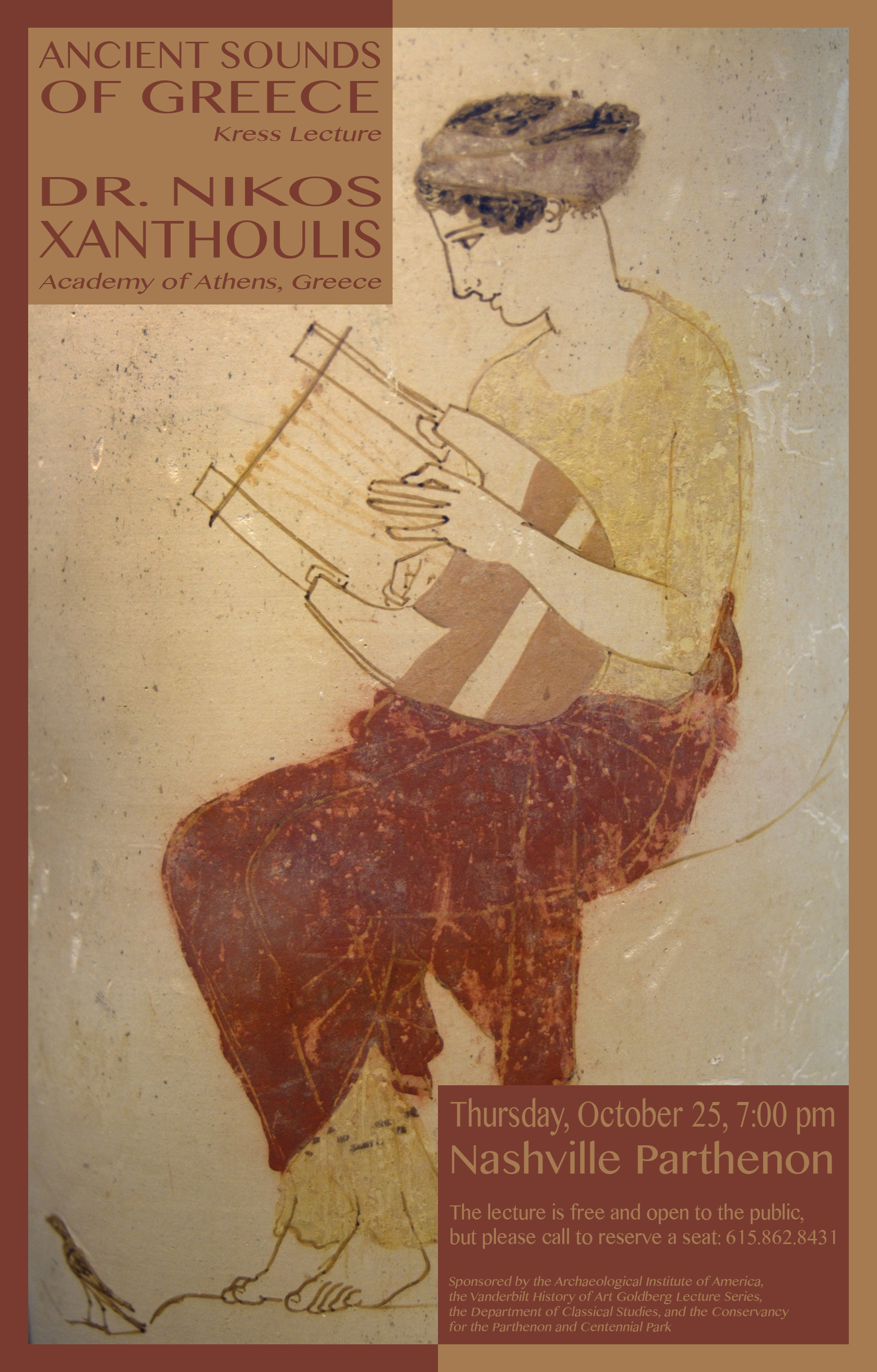 Nikos Xanthoulis, associate researcher with the Academy of Athens, Greece, and head of educational programs with the Greek National Opera, will deliver the Kress Lecture for the Nashville Society of the Archaeological Institute of America on Thursday, October 25. His lecture, “Ancient Sounds of Greece,” will begin at 7:00 p.m. in the Nashville Parthenon.
Nikos Xanthoulis, associate researcher with the Academy of Athens, Greece, and head of educational programs with the Greek National Opera, will deliver the Kress Lecture for the Nashville Society of the Archaeological Institute of America on Thursday, October 25. His lecture, “Ancient Sounds of Greece,” will begin at 7:00 p.m. in the Nashville Parthenon.
Using reconstructed instruments (the ancient lyre and the ancient trumpet, or salpinx), Xanthoulis will perform ancient Greek lyric songs, dating from 800 BCE to 400 CE, and examine the myths concerning music and musicians.
He holds degrees from the Sofia Music Academy (Ph.D.), the Panteion University of Athens, and the Athens and Athenaeum Conservatories. His fields of research are ancient Greek music, the ancient Greek trumpet (salpinx) and lyre, and the performance of ancient Greek lyric songs. He explores the history of ancient Greek music through original manuscripts, pottery, and traditional instruments.
Sponsored by the Archaeological Institute of America, the Vanderbilt History of Art Goldberg Lecture Series, the Department of Classical Studies, and the Conservancy for the Parthenon and Centennial Park, the lecture is free and open to the public. Call the Nashville Parthenon at 615.862.8431 to reserve a seat.
Posted by vrcvanderbilt on October 22, 2012 in HART, Lectures, VRC
Elizabeth Moodey Presents Paper at Manuscript Studies Conference
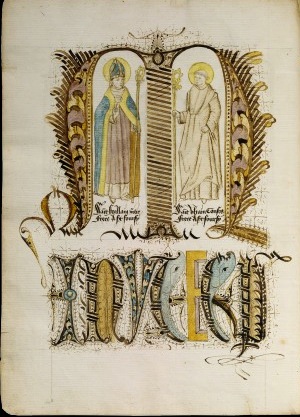 Jean Miélot (active 1448-ca. 1468), a translator and compiler who also devised the illustrated scratch copies that determined a book’s layout, was the most visual of the small army of scribal talents creating manuscripts for Philip the Good and the Burgundian court. Miélot was the focus of a paper, Towards a Portrait of a Late Medieval Mastermind: Jean Miélot, presented by Elizabeth Moodey, assistant professor of history of art, at the Saint Louis Conference on Manuscript Studies held October 12-13 at Saint Louis University.
Jean Miélot (active 1448-ca. 1468), a translator and compiler who also devised the illustrated scratch copies that determined a book’s layout, was the most visual of the small army of scribal talents creating manuscripts for Philip the Good and the Burgundian court. Miélot was the focus of a paper, Towards a Portrait of a Late Medieval Mastermind: Jean Miélot, presented by Elizabeth Moodey, assistant professor of history of art, at the Saint Louis Conference on Manuscript Studies held October 12-13 at Saint Louis University.
Although Paul Perdrizet worked admirably to establish Miélot’s oeuvre (in a foundational article published in 1907), his assessment of his subject’s skills—“médiocre copiste et encore plus médiocre enlumineur”—was disparaging. Working for Philip the Good, one of the greatest bibliophiles of the fifteenth century, Miélot was at the top of his profession. “Literary and art historical scholarship on Miélot has been channeled toward either his words or his images, which not only misses the richness of his activities but also leaves out crucial decorative and didactic elements in the illustrations he provided, such as figural diagrams and fantastic initials—work that lies between words and images,” said Moodey. “These elements often fail to catch the attention of art historians because they are not strictly figural, and likewise escape the eye of literary historians because they are not strictly textual.”
Moodey referred to Miélot’s so-called Commonplace Book (Paris, Bibliothèque nationale de France, MS fr. 17001), in which he collected designs and worked out translations. She noted that, as well as continuing to slight an unusually inventive talent, “we have been imposing modern notions of artist and editor and author on these figures in late-medieval bookmaking, and that the evidence points to something rather different.”
The Saint Louis Conference on Manuscript Studies, founded in 1974, is the only conference in North America dedicated strictly to manuscript topics. The two-day program offered sessions on a variety of themes relating to paleography, codicology, illumination, book production, and library history, among others.
Posted by vrcvanderbilt on October 18, 2012 in HART, VRC
HART Sponsors Roundtable Discussion on October 18 in the VRC
Join the Vanderbilt History of Art Society (HART) for a roundtable discussion on Thursday, October 18, at 4:00 p.m. in the Visual Resources Center (Cohen 134). Among the topics addressed will be: why History of Art offers great preparation for a wide range of careers; internship opportunities at Vanderbilt, in Nashville, and beyond; available funding for undergraduate research and training; the Honors Program in History of Art; and how to apply to graduate school.
Posted by vrcvanderbilt on October 12, 2012 in Events, Student/Alumni, VRC
Liberia Retold Through Photographs of Tim Hetherington
Long Story Bit by Bit: Liberia Retold, Photography by Tim Hetherington opens Friday, October 12, at the Vanderbilt Fine Arts Gallery and will be on view through December 6. An opening reception is scheduled from 5 to 7 p.m. in Cohen Memorial Hall on the Peabody campus and is part of The Ingram Commons’ Fall for the Arts celebration.
Tim Hetherington, an Oscar-nominated filmmaker and British photojournalist, documented the experience of war from the perspective of the individual, mostly in West Africa and the Middle East. His film Restrepo, which he co-directed with Sebastian Junger about a platoon of soldiers in Afghanistan’s Korengal Valley, was awarded the Grand Jury Prize at the 2010 Sundance Film Festival and was nominated for an Academy Award in 2011 for Best Documentary Feature.
Through his photography, writing, and films, Hetherington offered new ways to look at and think about human suffering. On April 20, 2011, while covering the conflict in Libya, Hetherington and fellow photographer Chris Hondros were killed by Libyan forces in a mortar attack on the besieged city of Misrata.
The exhibition entwines documentary photography, oral testimony, and memoir to explore the dynamics of power, international complicity, and the search for justice in recent Liberian history. Hetherington lived in Liberia on and off for several years, documenting with his Hasselblad the chaos and agony of war and the painful, slow reconciliations that followed.
Liberia, a country in West Africa, was founded by black Americans, many of whom were former slaves. Two of Liberia’s former presidents met grisly ends: William Tolbert was disemboweled during a coup d’état, and Samuel Doe was filmed while being tortured to death. More recently, former president Charles Taylor was sentenced to 50 years in prison for war crimes after becoming the first person to be tried and convicted by the International Criminal Court in The Hague. However, the terrible years of war and corruption have given way to a remarkable present, with 2011 Nobel Laureate Ellen Johnson-Sirleaf taking the country’s helm as Africa’s first female president.
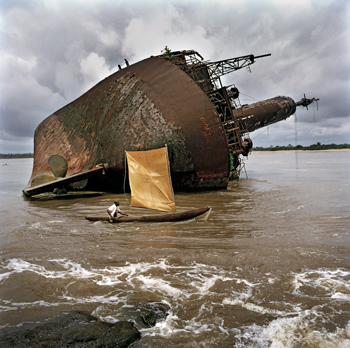 Long Story Bit by Bit brings to life an extraordinary range of characters—from warlords to presidents, environmental activists to traditional hunters, political hustlers to democratic visionaries—all captured by Hetherington over the course of eight years of living and working in West Africa, with four years spent in Liberia where he was a unique witness to the cycles of history. Hetherington was the recipient of Columbia University’s Alfred I. DuPont Award for excellence in broadcast journalism, a UK NESTA National Endowment Fellowship and four World Press Photo prizes, including the 2007 World Press Photo of the Year.
Long Story Bit by Bit brings to life an extraordinary range of characters—from warlords to presidents, environmental activists to traditional hunters, political hustlers to democratic visionaries—all captured by Hetherington over the course of eight years of living and working in West Africa, with four years spent in Liberia where he was a unique witness to the cycles of history. Hetherington was the recipient of Columbia University’s Alfred I. DuPont Award for excellence in broadcast journalism, a UK NESTA National Endowment Fellowship and four World Press Photo prizes, including the 2007 World Press Photo of the Year.
The exhibition, organized by Umbrage Editions and curated by Nan Richardson, is part of the campus wide initiative “Human Identities: Global, Local, Personal.” Sponsors are The Martha Rivers Ingram Commons, the Office of the Provost, the deans of the College of Arts and Science, Blair School of Music, School of Engineering, Peabody College, and Vanderbilt Fine Arts Gallery.
The Vanderbilt Fine Arts Gallery is located in Cohen Memorial Hall, 1220 21st Avenue South, on the western edge of the Peabody College campus. All events are free and open to the public. Gallery hours are noon to 4 p.m., Monday through Friday; noon to 8 p.m., Thursday; and 1-5 p.m., Saturday and Sunday.
Posted by vrcvanderbilt on October 4, 2012 in Events, Fine Arts Gallery, HART, VRC
Sculpture of Gabriel Warren on Permanent Display Near Cohen Hall
Four columns, each crafted from stainless steel and bronze, stand diagonally across from one another and gleam as they reflect the sunlight. Gabriel Warren’s outdoor sculpture installation, Piesterion: Diasematon 2, recently acquired by Vanderbilt, is on permanent display near Cohen Memorial Hall, which houses the University’s Fine Arts Gallery and the Departments of History of Art and Classical Studies. Originally it was installed as part of Polar Probings, an exhibit of works by the artist on view last year in the Fine Arts Gallery.
The first artist-in-residence in Antarctica, Warren creates sculptures using natural ice formations as source material. Layered with meaning and references to the condition of the planet, the artist’s works are based on his close observations of the behavior of ice in its many forms. Warren’s work is influenced by his profound interest in the environment and issues of sustainability. This outdoor installation is a response to ice cores extracted in Antarctica. Atmospheric gas bubbles trapped inside ice cores during their formation are represented in the sculpture by bronze plates that bisect the stainless steel columns.
“We were looking for an inaugural piece for the outdoor sculpture space being created adjacent to Cohen so the timing coincided perfectly with Mona Frederick introducing us to the environmental nature of Gabriel Warren’s work,” said Judson Newbern, deputy vice chancellor of facilities and environment at Vanderbilt. “The simplicity and strength in the elements that compose the sculpture work very well in that location.”
Dividing his time between his studio and residence in Rhode Island and his summer home in Nova Scotia near the sea, Warren travels frequently to Antarctica, making his 1999 trip as the recipient of a National Science Foundation “Artists and Writers in Antarctica” grant.
In addition to Warren’s many artistic accomplishments, he also is the son of acclaimed Vanderbilt alumnus Robert Penn Warren. Describing Vanderbilt’s acquisition of his work as “very heartwarming,” he added, “I’ve never lived in that part of the world, but it is very much a part of who I am. To have a piece as my representative there is kind of a closing of the circle. It is much more than another commission or sale.”
Posted by vrcvanderbilt on October 2, 2012 in Fine Arts Gallery, HART, VRC
Julia Murray to Examine Cult of Confucius in Goldberg Lecture
![]() Julia K. Murray, professor of art history in the departments of art history, East Asian studies, and religious studies at the University of Wisconsin, Madison, will deliver the Goldberg Lecture in Art History on Thursday, November 8, at 4:10 p.m. in Cohen Hall 203. Her lecture is entitled “The Cult of Confucius and the Shrine of His Robe and Cap.”
Julia K. Murray, professor of art history in the departments of art history, East Asian studies, and religious studies at the University of Wisconsin, Madison, will deliver the Goldberg Lecture in Art History on Thursday, November 8, at 4:10 p.m. in Cohen Hall 203. Her lecture is entitled “The Cult of Confucius and the Shrine of His Robe and Cap.”
Recognized throughout the world as the symbol of Chinese civilization, Confucius (551-479 BCE) is venerated as ancient philosopher, statesman, and teacher. Less familiar is his role in a religious cult supported over the centuries by Chinese emperors, officials, and scholars. After his death, a memorial shrine to Confucius in his hometown of Qufu, Shandong, gradually evolved into a large and magnificent temple. From the seventh century onward, schools throughout China also had temples for official worship.
The focus of Murray’s lecture is a shrine on the outskirts of Shanghai, whose 17th-century patrons claimed that it marked the place where his robe and cap had been buried a thousand years after his death. Using these unseen relics as a pretext, they built a ritual complex where scholarly pilgrims could offer sacrifices to the ancient sage and experience his beneficent presence. Like many sites associated with Confucius, Kongzhai was destroyed during the Cultural Revolution (1966-1976), but unlike most others, it has not been rebuilt. In presenting the history of the shrine, Murray will explore several ways that material forms of Chinese religious expression shaped Kongzhai’s architectural and artistic features and will conclude by speculating on the prospects for its revival.
Murray has held several research and curatorial positions in art museums with major East Asian collections, including the Metropolitan Museum of Art, Freer Gallery, and Harvard University Museum. She is the author of numerous scholarly articles and several monographs and exhibition catalogs, including Confucius: His Life and Legacy in Art (with Wensheng Lu, 2010), Mirror of Morality: Chinese Narrative Illustration and Confucian Ideology (2007), Ma Hezhi and the Illustration of the Book of Odes (1993), and Last of the Mandarins: Chinese Calligraphy and Painting from the F.Y. Chang Collection (1987).
Sponsored by the Norman L. and Roselea J. Goldberg Lecture Series (department of history of art), department of religious studies, and the Asian studies program, the lecture is free and open to the public. Cohen Memorial Hall is at 1220 21st Avenue South on the western edge of the Peabody College campus.
Posted by vrcvanderbilt on October 2, 2012 in HART, Lectures, VRC
Courtney Martin in Conversation with Frank Bowling at the Tate
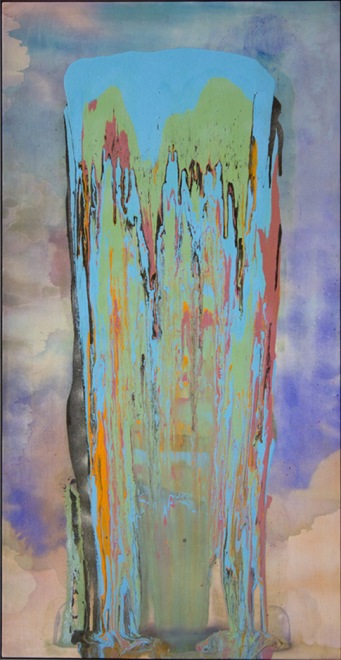 Courtney Martin, assistant professor of history of art, has organized an exhibition at the Tate Britain that opened on April 30 and features a series of “poured” paintings that British Guyana-born abstract artist Frank Bowling began in New York in the early 1970s. Martin will travel to London this month to participate in an artist’s talk and conversation with Bowling on October 12 at the Tate Britain.
Courtney Martin, assistant professor of history of art, has organized an exhibition at the Tate Britain that opened on April 30 and features a series of “poured” paintings that British Guyana-born abstract artist Frank Bowling began in New York in the early 1970s. Martin will travel to London this month to participate in an artist’s talk and conversation with Bowling on October 12 at the Tate Britain.
Bowling (born 1936), who studied at the Royal College of Art (1959-1962) with David Hockney and Derek Boshier, began his career as a figurative painter. He encountered the work of American abstract painters when he moved to New York in 1966 because New York, he told The Guardian, was “the frontline of artistic aspiration.” He became increasingly interested in the effects created by paint, and in 1973 he began to pour paint directly onto canvas, angled so that the wet acrylic paint would slowly flow to the bottom.
In his New York and London studios Bowling built a tilting platform that allowed him to pour the paints from heights of up to two meters. “The paint spilled down as if on a ski jump, creating an energetic and innovative action painting style,” said Martin. “The richly layered shifts of color could start as a straight line at the top of the canvas and end in a swirl at the bottom, meeting and meshing with other colors in the middle. A dense configuration of built-up paint settled at the bottom edge.”
Huge fluorescent canvases now (through April 30, 2013) dominate a white-walled room of the Tate, all of them produced in New York in the 1970s, in the space of just five years (1973-1978). Bowling exhibited the first group of these “poured” paintings in New York in the fall of 1973. Over the last thirty years he has developed his painting technique, adding other materials and thick layers of paint to the canvas. “Color and the material structure of the paint remain his primary concerns,” said Martin.
In 2005 Bowling became the first black British artist to be elected to the Royal Academy. He continues to paint every day and is pleased by the recent resurgence of interest in his work: six exhibitions so far this year and Mel Gooding’s monograph on his work recently published by the Royal Academy. Follow this link to see “Julia,” 1975 (top left) and other “poured” paintings by Bowling on display at the Tate Britain.
Posted by vrcvanderbilt on October 1, 2012 in Events, HART, Lectures, VRC
Vivien Fryd to Lecture in Berlin and Paris This Fall
Vivien Green Fryd, professor of history of art, currently a visiting professor at the John F. Kennedy Institute at the Freie Universität für Nordamerikastudien, Berlin, will lecture in Berlin and Paris this fall. As part of the Kennedy Institute’s lecture series, “The Sixties—America’s Longest Decade,” Fryd will address “The Sixties in American Art History: Media Expansion and Experimentation” in her lecture on November 14. She also will present a lecture, “The Transgenerational Trauma of Slavery in Faith Ringgold’s Slave Rape Story Quilt,” on December 4 in Paris sponsored by the Terra Visiting Professorship Program.
Awarded the visiting professorship by The Terra Foundation for American Art, Fryd is teaching two courses—American Art Since 1945 and American Icons and Monuments—to students in the Kennedy Institute’s American Studies program. The Terra Foundation actively supports and initiates historical American art exhibitions, scholarship, and programs abroad, and finances renowned scholars and professors of American art to teach at this institution in Germany as well as other countries.
Posted by vrcvanderbilt on October 1, 2012 in HART, Lectures, VRC
Francesca Tronchin to Deliver AIA Lecture on October 2
 Trained as a classical archaeologist and art historian, Francesca Tronchin, assistant professor of art history at Rhodes College, will deliver the inaugural lecture of the Nashville Society of the Archaeological Institute of America 2012-2013 series on Tuesday, October 2. Her lecture, “Interpreting Statuary in the Villas of Pompeii and Herculaneum,” will begin at 7 p.m. in the Nashville Parthenon.
Trained as a classical archaeologist and art historian, Francesca Tronchin, assistant professor of art history at Rhodes College, will deliver the inaugural lecture of the Nashville Society of the Archaeological Institute of America 2012-2013 series on Tuesday, October 2. Her lecture, “Interpreting Statuary in the Villas of Pompeii and Herculaneum,” will begin at 7 p.m. in the Nashville Parthenon.
Tronchin’s areas of specialization are Roman art and architecture, Roman domestic decor and collecting among the Romans, Pompeii, and fakes and forgeries in museums. Her research and teaching interests approach the visual culture of the ancient Mediterranean world with a social history perspective. She frequently engages with questions of the social function of works of art and architecture, especially in terms of personal identity and political propaganda.
Most of her research and teaching addresses the Bay of Naples region (i.e., Pompeii, Herculaneum) in Roman antiquity and its rediscovery, Greek and Roman sculpture, Roman domestic architecture and decoration, luxury arts in the classical world, and collecting, both ancient and modern. Tronchin is also interested in materials and technique of craft in antiquity, especially exotic luxury materials that are largely elusive to us today—citron wood, purple-dyed cloth, gemstones, and the enigmatic “Corinthian bronze.” Art crime, including archaeological looting, forgeries, and thefts, are also among her preoccupations.
Tronchin is currently at work on a book project entitled Eclecticism, Collecting, and Autobiography in the Houses of Rome and the Bay of Naples. She has published on the roles of nature imagery and simulation in Pompeian houses, eclecticism and collecting habits, Roman architecture, and the House of Octavius Quartio at Pompeii.
An accomplished photographer, Tronchin will illustrate her lecture with stunning images. Co-sponsored by the Department of Classical Studies and the History of Art Goldberg Lecture Series, the lecture, followed by a reception, is free and open to the public. Call the Nashville Parthenon at 615.862.8431 to reserve a seat.
Posted by vrcvanderbilt on September 26, 2012 in HART, Lectures, VRC


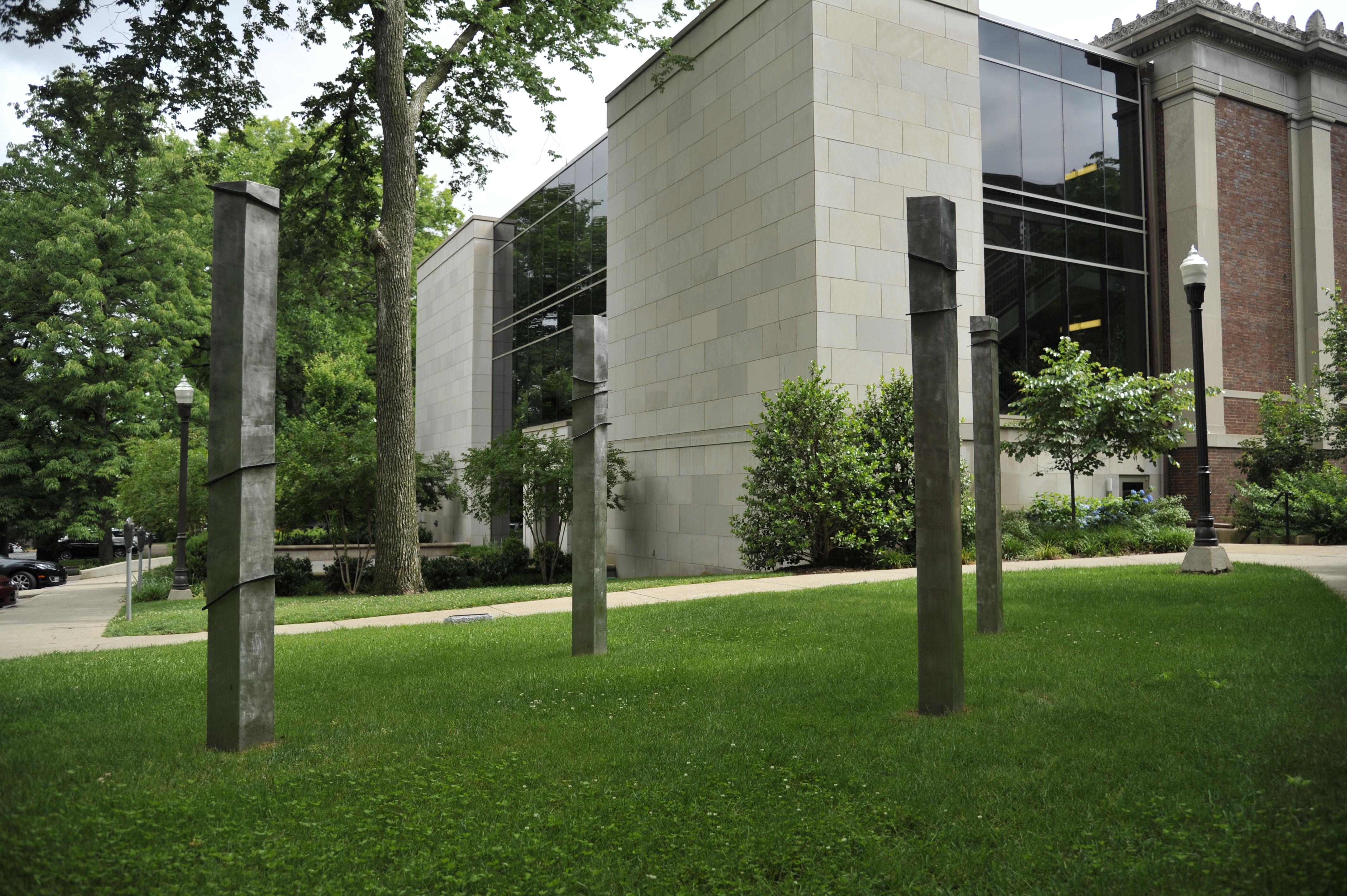
©2025 Vanderbilt University ·
Site Development: University Web Communications